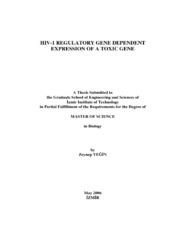Please use this identifier to cite or link to this item:
https://hdl.handle.net/11147/3407Full metadata record
| DC Field | Value | Language |
|---|---|---|
| dc.contributor.advisor | Arslanoğlu, Alper | - |
| dc.contributor.author | Yeğin, Zeynep | - |
| dc.date.accessioned | 2014-07-22T13:51:29Z | - |
| dc.date.available | 2014-07-22T13:51:29Z | - |
| dc.date.issued | 2006 | - |
| dc.identifier.uri | http://hdl.handle.net/11147/3407 | - |
| dc.description | Thesis(Master)--İzmir Institute of Technology, Biology, İzmir, 2006 | en_US |
| dc.description | Includes bibliographical references (p.103-110) | en_US |
| dc.description | Text in English; Abstract: Turkish and English | en_US |
| dc.description | xvii, 116 leaves | en_US |
| dc.description.abstract | From the first day it was discovered, HIV remains as one the major health threats of 21st century and the methods tried up to now focused on the short-term solutions which were efficient at blocking HIV replication, but also resulted with drugresistant strains, instead of methods which would completely eliminate HIV-infected cells from potential reservoirs. In this study, the design of a special DNA vector encoding a toxic protein to be expressed only in cells infected with HIV, thereby not damaging to healthy cells and the test of the efficacy of this vector in the cell culture conditions without using HIV infection was aimed. The toxic gene (suicide gene) presumed to create the desired effect was placed under the transcriptional control of HIV promoter LTR and so that the expression of the toxic gene was made dependent upon the tat regulator gene of HIV. In order to prevent leaky gene expression stemming from the basal gene expression from LTR even if it was not induced by Tat, and thereby having potential to damage healthy cells, the prerequisite cis-acting DNA sequences were cloned downstream of the toxic gene. So that, the transcripts produced could retain in the nucleus and would require the function of a second regulator protein 'Rev' which is a molecular chaperone for being transmitted into the cytoplasm. If the efficiency of this model prooved, a full-protective suicide vector will have been designed and this vector may be suggested to be tested in gene therapy trials of HIV infection in the future. | en_US |
| dc.language.iso | en | en_US |
| dc.publisher | İzmir Institute of Technology | en_US |
| dc.rights | info:eu-repo/semantics/openAccess | en_US |
| dc.subject.lcsh | HIV infections | en |
| dc.subject.lcsh | AIDS (Disease) | en |
| dc.title | Hiv-1 Regulatory Gene Dependent Expression of a Toxic Gene | en_US |
| dc.type | Master Thesis | en_US |
| dc.institutionauthor | Yeğin, Zeynep | - |
| dc.department | Thesis (Master)--İzmir Institute of Technology, Molecular Biology and Genetics | en_US |
| dc.relation.publicationcategory | Tez | en_US |
| dc.identifier.wosquality | N/A | - |
| dc.identifier.scopusquality | N/A | - |
| item.openairecristype | http://purl.org/coar/resource_type/c_18cf | - |
| item.languageiso639-1 | en | - |
| item.openairetype | Master Thesis | - |
| item.grantfulltext | open | - |
| item.fulltext | With Fulltext | - |
| item.cerifentitytype | Publications | - |
| Appears in Collections: | Master Degree / Yüksek Lisans Tezleri | |
Files in This Item:
| File | Description | Size | Format | |
|---|---|---|---|---|
| T000556.pdf | MasterThesis | 2.03 MB | Adobe PDF |  View/Open |
CORE Recommender
Page view(s)
260
checked on Mar 31, 2025
Download(s)
174
checked on Mar 31, 2025
Google ScholarTM
Check
Items in GCRIS Repository are protected by copyright, with all rights reserved, unless otherwise indicated.